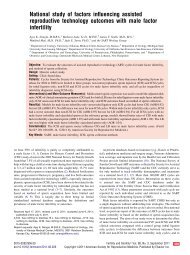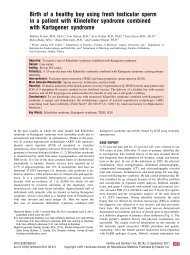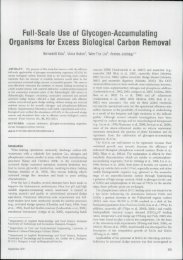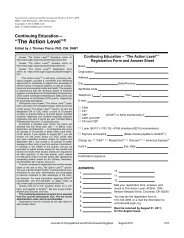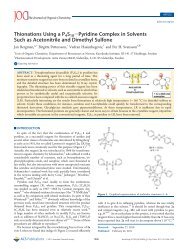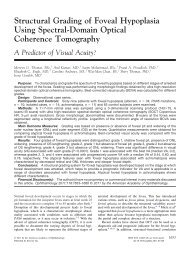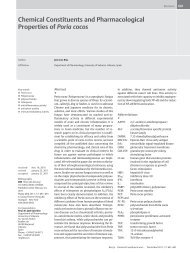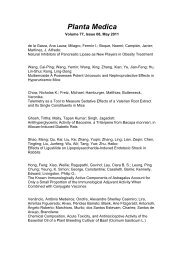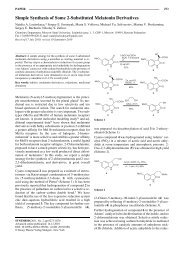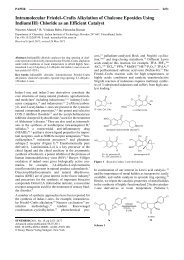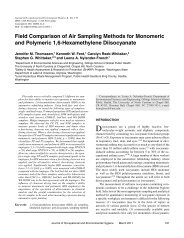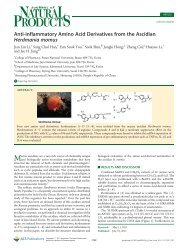You also want an ePaper? Increase the reach of your titles
YUMPU automatically turns print PDFs into web optimized ePapers that Google loves.
PAPER 715<br />
<strong>Total</strong> <strong>Syntheses</strong> <strong>of</strong> (<strong>±</strong>)-(Z)- <strong>and</strong> (<strong>±</strong>)-(E)-9-(Bromomethylene)-1,5,5-trimethylspiro[5.5]undeca-1,7-dien-3-one<br />
<strong>and</strong> (<strong>±</strong>)-Majusculone<br />
<strong>Total</strong> Jia-Liang <strong>Syntheses</strong> <strong>of</strong> Chamigrene Sesquiterpenoids Zhu,* a Po-Wei Huang, a Ruei-Yi You, a Fa-Yan Lee, a Sheng-Wei Tsao, a I-Chia Chenb a Department <strong>of</strong> Chemistry, National Dong Hwa University, Hualien 974, Taiwan, R. O. C.<br />
Fax +886(3)8633570; E-mail: jlzhu@mail.ndhu.edu.tw<br />
b Department <strong>of</strong> Cosmetic Applications <strong>and</strong> Management, Cardinal Tien College <strong>of</strong> Healthcare <strong>and</strong> Management, Taipei, Taiwan, R. O. C.<br />
Received 16 November 2010; revised 20 December 2010<br />
Abstract: A new total synthesis <strong>of</strong> the chamigrene sesquiterpenoids<br />
(Z)-9-(bromomethylene)-1,5,5-trimethylspiro[5.5]undeca-<br />
1,7-diene-3-one <strong>and</strong> its 15-E-epimer has been accomplished in 13<br />
steps. In our sequence, a Diels–Alder reaction <strong>and</strong> subsequent reductive<br />
alkylation <strong>of</strong> the resulting adduct was utilized as the key<br />
strategy to create the A-ring <strong>and</strong> the quaternary spirocenter with the<br />
suitable functionalities for accessing the B-ring. Additionally, from<br />
the advanced intermediate, a total synthesis <strong>of</strong> (<strong>±</strong>)-majusculone, a<br />
nor-chamigrene natural product, was also readily achieved in two<br />
steps.<br />
Key words: chamigrenes, sesquiterpenes, majusculone, total syntheses,<br />
Diels–Alder reaction<br />
In the past years, over one hundred members <strong>of</strong> chamigrene-type<br />
sesquiterpenoids have been isolated from natural<br />
sources. 1 Structurally, these natural products are<br />
characterized by a spiro[5.5]undecane skeleton with two<br />
vicinal quaternary carbon centers at C-5 <strong>and</strong> C-6 positions<br />
(Figure 1). Many chamigrenes, especially those being halogenated<br />
by bromine <strong>and</strong>/or chlorine atom(s), have been<br />
shown to possess a wide variety <strong>of</strong> interesting biological<br />
activities1a such as antibacterial2b <strong>and</strong> antifungal2c properties,<br />
<strong>and</strong> the cytotoxicity against a range <strong>of</strong> cancer cell<br />
lines. 1b,f,g,j,2a Besides, this class <strong>of</strong> natural products has<br />
also attracted considerable interest from synthetic community,<br />
as reflected by a number <strong>of</strong> documented examples<br />
on their total syntheses. 3<br />
Belonging to the chamigrene family, (Z)-9-(bromomethylene)-1,5,5-trimethylspiro[5.5]undeca-1,7-diene-3-one<br />
(1) <strong>and</strong> its 15-E-epimer 2 (Figure 1) were both isolated<br />
from the red algae Laurencia majuscula Harvey. 4,5 Their<br />
spirobicyclic framework is composed by an A-ring carrying<br />
a C1–C3 enone moiety <strong>and</strong> a B-ring containing a C7–<br />
C8 double bond conjugated with an exo-bromomethylene<br />
functionality. Like many other chamigrenes, the intriguing<br />
structural features make 1 <strong>and</strong> 2 attractive targets for<br />
total synthesis. In 1983, Iwata <strong>and</strong> co-workers reported<br />
the first total synthesis <strong>of</strong> 1 <strong>and</strong> 2 by using a copper-catalyzed<br />
cyclization <strong>of</strong> a phenolic a-diazo ketone to create<br />
the core structure (Scheme 1). 6 Following this, Niwa’s<br />
group7 described the second total synthesis by employing<br />
an acid-promoted spiroannulation <strong>of</strong> an enone aldehyde<br />
SYNTHESIS 2011, No. 5, pp 0715–0722xx.xx.2011<br />
Advanced online publication: 18.01.2011<br />
DOI: 10.1055/s-0030-1258412; Art ID: F20510SS<br />
© Georg Thieme Verlag Stuttgart · New York<br />
derived from anisole to construct the spirocyclic skeleton.<br />
In these synthetic routes, however, the key spirocyclic intermediates<br />
were produced either in a relatively low yield<br />
(22%) 6 or as an inseparable mixture with a tricyclic regioisomer.<br />
7<br />
15<br />
X<br />
Y<br />
15<br />
9<br />
B<br />
7<br />
6 1<br />
A<br />
Figure 1 Skeleton <strong>of</strong> chamigrene <strong>and</strong> structures <strong>of</strong> 1, 2, <strong>and</strong> 3<br />
OH<br />
8<br />
9<br />
13<br />
OMe<br />
7<br />
6<br />
5<br />
14<br />
12<br />
1<br />
4 steps<br />
OH<br />
O<br />
4 steps<br />
3<br />
OH<br />
O<br />
Scheme 1 Iwata’s <strong>and</strong> Niwa’s synthetic approaches to 1 <strong>and</strong> 2<br />
We herein wish to report the third total synthesis <strong>of</strong> (<strong>±</strong>)-1<br />
<strong>and</strong> (<strong>±</strong>)-2 based on an approach to highly substituted cyclohexene<br />
system as recently developed by Liu’s <strong>and</strong> our<br />
laboratories. 8 In our synthetic sequence, a Diels–Alder reaction<br />
<strong>of</strong> an a-cyano a,b-unsaturated ester <strong>and</strong> a lithium<br />
naphthalenide (LN)-induced reductive alkylation <strong>of</strong> the<br />
resulting adduct were employed as the key operations to<br />
create the A-ring <strong>and</strong> the quaternary spirocenter <strong>of</strong> 1 <strong>and</strong><br />
2. In addition, a total synthesis <strong>of</strong> (<strong>±</strong>)-majusculone (3,<br />
Figure 1), a naturally occurring 9-norchamigrene-type<br />
metabolite first isolated with 2, 1h,5 was also achieved from<br />
an advanced intermediate leading to 1 <strong>and</strong> 2 through simple<br />
operations.<br />
As outlined in our initial retrosynthetic analysis<br />
(Scheme 2), we envisioned that the Diels–Alder reaction<br />
3<br />
O<br />
X = Br, Y = H<br />
1:<br />
X = H, Y = Br<br />
2:<br />
N2<br />
O<br />
CuCl 2<br />
O<br />
HCl<br />
CHO<br />
O<br />
O OH<br />
3<br />
O<br />
O<br />
steps 6<br />
(<strong>±</strong>)-1 <strong>and</strong> 2<br />
5 steps
716 J.-L. Zhu et al. PAPER<br />
between 2-cyano-3-methylbut-2-enoic acid ethyl ester (4)<br />
<strong>and</strong> the Danishefsky-type diene 5 could be used to create<br />
the A-ring <strong>of</strong> 1 <strong>and</strong> 2 in a single step with the concomitant<br />
introduction <strong>of</strong> the C-5 quaternary center <strong>and</strong> the C-1<br />
methyl group. In addition, the silyl enol ether moiety <strong>of</strong><br />
the resulting adduct 6 would be easily converted into the<br />
requisite enone functionality to afford the intermediate 7.<br />
After protecting the carbonyl group <strong>of</strong> 7, the cyano group<br />
would be elaborated into a but-3-enyl appendage through<br />
a reductive alkylation operation to give the intermediate 8.<br />
Then, the terminal vinyl moiety <strong>of</strong> 8 has to be changed<br />
into a keto functionality while the ester moiety has to be<br />
converted into a formyl group to afford the keto aldehyde<br />
9. Subsequent intramolecular aldol condensation <strong>of</strong> 9<br />
would allow the establishment <strong>of</strong> the spirocyclic core, by<br />
giving rise to intermediate 10. Finally, Wittig reaction<br />
<strong>of</strong> 10 with trimethylphosphonium bromomethylide<br />
(Ph 3P=CHBr) followed by the respective deprotection <strong>of</strong><br />
the resulting E- <strong>and</strong> Z-isomers would complete the total<br />
synthesis <strong>of</strong> 1 <strong>and</strong> 2.<br />
O<br />
9<br />
8<br />
1 <strong>and</strong> 2<br />
7<br />
EtO 2C CN<br />
10<br />
+<br />
OPG<br />
OTBS<br />
OHC<br />
EtO 2C<br />
OTBS<br />
5<br />
6<br />
4<br />
Scheme 2 Retrosynthetic analysis <strong>of</strong> 1 <strong>and</strong> 2<br />
In a modified procedure, our synthetic effort began with<br />
the condensation <strong>of</strong> ethyl cyanoacetate with acetone to<br />
provide the known compound 49 in 66% yield (Scheme 3).<br />
After this, the Diels–Alder reaction <strong>of</strong> 4 with diene 510 was carried out. It was observed that with the assistance <strong>of</strong><br />
zinc chloride, 4 could readily undergo the cycloaddition<br />
with 5 (5 equiv) in toluene at 80 °C, to afford the desired<br />
adduct 6 as a diastereomeric mixture (ortho-like, 50:50) in<br />
good yield (82%), together with the by-product 11 resulting<br />
from the self-addition <strong>of</strong> 5 (0.6 out <strong>of</strong> 5 equiv) as a single<br />
diastereomer. 11 As we designed, compound 6 should<br />
be directly transformed into enone 7, <strong>and</strong> for this purpose,<br />
two commonly employed reagent systems for converting<br />
silyl enol ether into enone, including 2,3-dichloro-5,6-dicyanobenzoquinone<br />
(DDQ)/benzene12a <strong>and</strong> Pd(OAc) 2/<br />
Na2CO3/MeCN, 12b were respectively attempted on 6 at<br />
different temperatures (r.t. to reflux). However, these reactions<br />
only led to recovered starting material or complex<br />
mixtures.<br />
We envisaged that the failure met with the transformation<br />
<strong>of</strong> 6 into 7 through the DDQ oxidation might be attributed<br />
Synthesis 2011, No. 5, 715–722 © Thieme Stuttgart · New York<br />
O<br />
9<br />
PG = protecting group<br />
CN<br />
OPG<br />
EtO 2C<br />
EtO 2C<br />
8<br />
CN<br />
7<br />
OPG<br />
O<br />
6<br />
2C CN EtO a<br />
66%<br />
c or d<br />
EtO2C<br />
2C 2<br />
EtO<br />
1<br />
4<br />
CN<br />
EtO2C<br />
b<br />
≡<br />
OTBS<br />
6 (50:50) (82%)<br />
OTBS<br />
H<br />
O EtO<br />
12<br />
Scheme 3 Reagents <strong>and</strong> conditions: (a) LiBr (5.0 equiv), MS 3Å,<br />
acetone, reflux, 18 h; (b) 5 (5.0 equiv), ZnCl2 (1.0 equiv), toluene, 80<br />
°C, 20 h; (c) LN (3.5 equiv), THF, –45 °C, 30 min, then<br />
H2C=CHCH2CH2Br (4 equiv), r.t., 24 h, 57% <strong>of</strong> 12; (d) LN (3.5<br />
equiv), THF, –45 °C, 30 min, then H2C=CHCH2CH2Br (4 equiv),<br />
HMPA (4 equiv), r.t., 12 h, 70% <strong>of</strong> 12.<br />
to the unfavorable electronic effect <strong>of</strong> the cyano group to<br />
the cation intermediate. In this regard, it was decided to<br />
reroute our original scheme by conducting the reductive<br />
alkylation <strong>of</strong> 6 first, to replace its cyano group with a but-<br />
3-enyl appendage. Following the previously established<br />
reaction conditions, 8 the reductive alkylation reaction was<br />
initially performed by treating 6 with LN (3.5 equiv) 13 in<br />
THF at –45 °C for 30 minutes, followed by trapping the<br />
resulting enolate from the reductive decyanation with 4bromobut-1-ene<br />
(4 equiv), affording the alkylated product<br />
12 in 57% yield as a single diastereomer. The trans steric<br />
relationship between C-1 butenyl <strong>and</strong> C-2 methyl groups<br />
was verified by 2D NOESY correlations as illustrated in<br />
Scheme 3. It was further discovered that a much better<br />
yield <strong>of</strong> 12 (70%) could be obtained by the use <strong>of</strong> hexamethylphosphoramide<br />
(HMPA) (4 equiv) as an activating<br />
reagent.<br />
With the cyano group having been replaced by the alkyl<br />
group, treatment <strong>of</strong> 12 with DDQ (5 equiv) in benzene at<br />
80 °C for 24 hours could indeed affect the formation <strong>of</strong> the<br />
enone moiety as evidenced by the low yield (~10%) <strong>of</strong> 13<br />
obtained. To improve the yield <strong>of</strong> 13, we continued to examine<br />
several reaction conditions by combining DDQ respectively<br />
with several bases, including K2CO3, 2,4,6collidine,<br />
14 <strong>and</strong> 2,6-lutidine, in benzene. Among the bases<br />
tested, the best result was obtained from the reaction <strong>of</strong><br />
DDQ (4.8 equiv) in 2,6-lutidine (5.1 equiv) affording 13<br />
in 55% yield (brsm: 72%), plus 30% <strong>of</strong> recovered 12<br />
(Scheme 4). Regarding the inherent instability <strong>of</strong> the<br />
enone, we thought that the carbonyl group <strong>of</strong> 13 should be<br />
protected before creating the B-ring. To this end, 13 was<br />
first reduced under the Luche’s conditions to give the allyic<br />
alcohol 14 in 79% yield as a diastereomeric mixture<br />
(76:24). The formation <strong>of</strong> two isomers in this case should<br />
O<br />
CN<br />
+<br />
11<br />
Me<br />
H<br />
H<br />
EtO2C<br />
OTBS<br />
OTBS<br />
H<br />
CN<br />
7<br />
O
PAPER <strong>Total</strong> <strong>Syntheses</strong> <strong>of</strong> Chamigrene Sesquiterpenoids 717<br />
12<br />
a<br />
55%<br />
72%)<br />
(brsm:<br />
O<br />
EtO 2C<br />
Scheme 4 Reagents <strong>and</strong> conditions: (a) DDQ (4.8 equiv), 2,6-lutidine (5.1 equiv), benzene, r.t., 24 h, 30% <strong>of</strong> 12 was recovered; (b)<br />
CeCl 3·7H 2O (1.5 equiv), NaBH 4 (1.8 equiv), MeOH–CH 2Cl 2 (1:1), 0 °C, 1 h; (c) TBDMSCl (1.5 equiv), imidazole (2.5 equiv), DMF, r.t., 12<br />
h; (d) PdCl 2 (0.25 equiv), CuCl (1.4 equiv), O 2, DMF–THF–H 2O, r.t., 20 h, 20% <strong>of</strong> 15 was recovered; (e) LiAlH 4 (6 equiv), THF, 0 °C to r.t.,<br />
5 h; (f) PDC (3 equiv), CH 2Cl 2, r.t., 12 h; (g) KOH (1.6 equiv, 1.0 M in MeOH), THF, r.t., 3 h; (h) piperidine (2.94 equiv), n-BuLi (2.98 equiv),<br />
BrCH 2(Ph) 3P + Br – (3.02 equiv), THF, 0 °C, 80 min; (i) TBAF (2.0 equiv), THF, r.t., 2 h; (j) PDC (2.0 equiv), CH 2Cl 2, r.t., 1 h.<br />
be inconsequential to the final targets since the newly created<br />
stereogenic center would be eventually eliminated.<br />
Compound 14 was then subjected to the protection with<br />
tert-butyldimethylsilyl chloride (TBDMSCl) in the presence<br />
<strong>of</strong> imidazole to provide the silyl ether 15 (75:25) in<br />
82% yield.<br />
In an effort to access the spirocyclic core, the Wacker oxidation<br />
<strong>of</strong> 15 was first conducted under the st<strong>and</strong>ard reaction<br />
conditions, 15 to afford the keto ester 16 in 53% yield<br />
(74:26) (brsm: 63.5%), along with 20% <strong>of</strong> recovered starting<br />
material. Exposure <strong>of</strong> 16 to lithium aluminum hydride<br />
(LiAlH4) in THF resulted in the formation <strong>of</strong> diol 17 with<br />
only two isomers (77:23) as detected by the 1H NMR<br />
spectrum <strong>of</strong> the crude 17. Without purification, the crude<br />
17 was immediately subjected to oxidation with pyridinium<br />
dichromate (PDC), <strong>and</strong> the resulting keto aldehyde intermediate,<br />
still as a crude mixture, underwent the aldol<br />
condensation smoothly on treatment with KOH in a THF–<br />
MeOH solution, 16 to yield the key spiro intermediate 18 in<br />
44% yield over three steps.<br />
With 18 in place, the remainder <strong>of</strong> the synthesis then proceeded<br />
smoothly. As we expected, Wittig reaction <strong>of</strong> 18<br />
13<br />
44% over 3 steps<br />
18 (83:17)<br />
O<br />
b<br />
79%<br />
HOH 2C<br />
f, g<br />
h<br />
61%<br />
OTBS<br />
Br<br />
EtO2C<br />
OH<br />
17 (77:23)<br />
OH<br />
(76:24) 14<br />
OTBS<br />
19 (61:21:15:5)<br />
OTBS<br />
e<br />
c<br />
82%<br />
EtO2C<br />
53% d<br />
63.5%)<br />
(brsm:<br />
i<br />
90%<br />
EtO2C<br />
X<br />
Br<br />
Y<br />
2<br />
3<br />
OTBS<br />
(75:25) 15<br />
O<br />
OTBS<br />
(74:26) 16<br />
20 (60:22:13:5)<br />
j<br />
with trimethylphosphonium bromomethylide generated<br />
from (bromomethyl)triphenylphosphonium bromide <strong>and</strong><br />
lithium piperidide17 proceeded smoothly to afford the bromomethylene<br />
derivative 19 as an isomeric mixture (E-major/Z-major/E-minor/Z-minor<br />
= 61:21:13:5) in 61% yield.<br />
Without separation, 19 was subsequently subjected to the<br />
deprotection with tetra-n-butylammonium fluoride<br />
(TBAF) in THF to afford the alcohol 20 (60:22:13:5) in an<br />
almost quantitative yield (90%). At the end, oxidation <strong>of</strong><br />
20 with PDC furnished the final targets (<strong>±</strong>)-1 <strong>and</strong> its 15-Eepimer<br />
(<strong>±</strong>)-2 in 26% <strong>and</strong> 53% yield, respectively. The<br />
spectral data ( 1H <strong>and</strong> 13C NMR) <strong>of</strong> both products were<br />
found to agree well with those reported in the literature. 5,7<br />
In addition to 1 <strong>and</strong> 2, the total synthesis <strong>of</strong> (<strong>±</strong>)-majusculone<br />
(3), a 9-nor-chamigrene natural product, was also<br />
readily achieved from the advanced intermediate 18 in<br />
two steps. As shown in Scheme 5, deprotection <strong>of</strong> 18 with<br />
TBAF followed by treatment <strong>of</strong> the resulting crude alcohol<br />
with PDC completed the synthesis <strong>of</strong> 3 in 82% yield<br />
over two steps, the spectroscopic data <strong>of</strong> which were<br />
found to be identical to both natural5 <strong>and</strong> synthetic products.<br />
18<br />
Synthesis 2011, No. 5, 715–722 © Thieme Stuttgart · New York<br />
OH<br />
O<br />
X = Br, Y = H (26%)<br />
(<strong>±</strong>)-1:<br />
X = H, Y = Br (53%)<br />
(<strong>±</strong>)-2:
718 J.-L. Zhu et al. PAPER<br />
18<br />
a, b<br />
82% over 2 steps<br />
O<br />
(<strong>±</strong>)-3<br />
Scheme 5 Reagents <strong>and</strong> conditions: (a) TBAF (5.0 equiv), THF,<br />
r.t., 3 h; (b) PDC (2.0 equiv, based on 24), CH2Cl2, r.t., 2 h.<br />
In summary, we have accomplished the total synthesis <strong>of</strong><br />
1 <strong>and</strong> 2 in 13 steps through a novel synthetic approach. Although<br />
the ultimate synthesis did not strictly follow the<br />
initially designed scheme, our original goals <strong>of</strong> using the<br />
Diels–Alder reaction to construct the A-ring <strong>and</strong> the reductive<br />
alkylation <strong>of</strong> the Diels–Alder adduct to create the<br />
spiro quaternary center with the suitable functionalities<br />
for accessing the B-ring have been well realized. In the<br />
synthetic sequence, some intermediates were produced as<br />
the isomeric mixtures, but the separations <strong>of</strong> them were<br />
shown to be unnecessary since all <strong>of</strong> the isomers could be<br />
eventually converted into either <strong>of</strong> the targets. In comparison<br />
with the previously reported syntheses (overall<br />
yields: 0.31% 6 <strong>and</strong> 4.51% 7 for 1, 2.12% 6 <strong>and</strong> 0.45% 7 for<br />
2, respectively), the current study did not result in a significant<br />
improvement on the overall yields <strong>of</strong> 1 (0.85%) <strong>and</strong><br />
2 (1.74%), but the synthetic route developed by us appears<br />
to be more general <strong>and</strong> the generality has been demonstrated<br />
by the ready achievement <strong>of</strong> (<strong>±</strong>)-majusculone (3)<br />
from the intermediate leading to 1 <strong>and</strong> 2. The application<br />
<strong>of</strong> the same strategy for the syntheses <strong>of</strong> other members <strong>of</strong><br />
chamigrene family is the focus <strong>of</strong> our ongoing studies.<br />
Unless otherwise noted, all starting materials <strong>and</strong> reagents were<br />
purchased from commercial suppliers <strong>and</strong> used without further purification.<br />
THF was distilled from sodium-benzophenone; toluene,<br />
benzene, CH 2Cl 2, <strong>and</strong> DMF were distilled from CaH 2 before use.<br />
TLC analysis <strong>and</strong> preparative TLC were performed on Macherey-<br />
Nagel DC-Fertigplatten. Durasil-25 UV 254 glass-backed plates, <strong>and</strong><br />
visualized by UV, or KMnO 4 or I 2 treatment. All <strong>of</strong> the products<br />
were purified by flash chromatography on Merck Kieselgel 60 (Art.<br />
9385) (230–400 mesh) or neutral aluminum oxide. IR spectra were<br />
recorded on a Jasco FT/IR 410 spectrometer. NMR spectra ( 1 H, 13 C,<br />
DEPT, NOESY) were recorded on a Bruker Avance DPE-400 or a<br />
Bruker Avance DPE-600 spectrometer using CDCl 3 or C 6D 6 as solvent.<br />
High-resolution mass spectra (HRMS) <strong>and</strong> low-resolution<br />
mass spectra (LRMS) were recorded on a Finnigan/Thermo Quest<br />
MAT 95XL spectrometer in a fast atom bombardment (FAB) model.<br />
Ethyl 2-Cyano-3-methylbut-2-enoate (4)<br />
This known compound was prepared by a modified procedure as<br />
follows. LiBr (7.82 g, 0.09 mol) <strong>and</strong> molecular sieves 3Å (300 mg)<br />
were added to a mixture <strong>of</strong> ethyl cyanoacetate (2.0 g, 0.018 mol)<br />
<strong>and</strong> acetone (60 mL). The suspension was refluxed for 18 h, cooled<br />
to r.t., filtered, <strong>and</strong> concentrated in vacuo. The residue was diluted<br />
with EtOAc (300 mL), washed with H 2O (2 × 50 mL) <strong>and</strong> brine (50<br />
mL), <strong>and</strong> concentrated. The crude mixture was subjected to chromatographic<br />
purification on silica gel (hexane–EtOAc, 20:1) to<br />
yield 4 (1.82 g, 66%).<br />
Synthesis 2011, No. 5, 715–722 © Thieme Stuttgart · New York<br />
O<br />
4-(tert-Butyldimethylsilyloxy)-1-cyano-2,6,6-trimethylcyclohex-3-enecarboxylic<br />
Acid Ethyl Ester (6) <strong>and</strong> 1-[(1R*,2S*,6S*)-<br />
4-(tert-Butyldimethylsilyloxy)-2,6-dimethylcyclohex-3enyl]ethanone<br />
(11)<br />
To a flame-dried 100 mL round-bottom flask were added anhyd<br />
ZnCl 2 (804 mg, 5.9 mmol) <strong>and</strong> anhyd toluene (20 mL). The resulting<br />
suspension was stirred under a N 2 atmosphere for 20 min before<br />
treating with a solution <strong>of</strong> 4 (904 mg, 5.9 mmol) in anhyd toluene<br />
(4 mL). After stirring for an additional 30 min, a solution <strong>of</strong> diene<br />
5 10 (5.85 g, 29.5 mmol) in anhyd toluene (8 mL) was added to the<br />
mixture. The mixture was then stirred at 80 °C for 20 h, cooled to<br />
r.t., <strong>and</strong> diluted with EtOAc (120 mL). The solution was successively<br />
washed with H 2O (2 × 30 mL) <strong>and</strong> brine (20 mL), dried<br />
(Na 2SO 4), filtered, <strong>and</strong> concentrated under reduced pressure. Chromatographic<br />
purification <strong>of</strong> the crude residue on silica gel (hexane–<br />
EtOAc, 100:1, 60:1, <strong>and</strong> 40:1) afforded 11 11 (500 mg, generated<br />
from 0.6 out <strong>of</strong> 5 equiv <strong>of</strong> 5) as a colorless sticky oil, followed by 6<br />
(1.7 g, 82%) as a mixture <strong>of</strong> two isomers (50:50).<br />
6<br />
IR (neat): 2960, 2931, 2857, 2242, 1739, 1671, 1463, 1363, 1259,<br />
1207, 838, 781 cm –1 .<br />
1H NMR (400 MHz, CDCl3): d (isomer 1) = 4.57 (br s, 1 H), 4.35–<br />
4.16 (m, 2 H), 3.04–2.95 (m, 1 H), 2.42 (br d, J=17.5 Hz, 1 H),<br />
1.76 (d, J=17.5 Hz, 1 H), 1.33 (t, J=7.2 Hz, 3 H), 1.18–1.05 (m,<br />
9 H), 0.90 (s, 9 H), 0.15 (s, 3 H), 0.14 (s, 3 H); d (isomer 2) = 4.51<br />
(br s, 1 H), 4.35–4.16 (m, 2 H), 2.90–2.82 (m, 1 H), 2.41 (d, J=17.3<br />
Hz, 1 H), 1.74 (d, J=17.3 Hz, 1 H), 1.30 (t, J=7.1 Hz, 3 H), 1.24<br />
(s, 3 H), 1.16–1.05 (m, 6 H), 0.90 (s, 9 H), 0.14 (s, 3 H), 0.13 (s, 3<br />
H).<br />
13C NMR (100 MHz, CDCl3): d (isomer 1) = 167.7, 148.7, 117.6,<br />
105.6, 62.4, 58.9, 43.0, 37.6, 33.4, 27.1, 25.6, 22.0, 18.2, 17.9, 14.2,<br />
–4.3, –4.6; d (isomer 2) = 165.9, 149.3, 119.8, 103.7, 61.9, 57.2,<br />
40.5, 37.0, 35.9, 26.8, 26.0, 25.6, 17.9, 17.3, 14.2, –4.3, –4.5.<br />
HRMS-FAB: m/z calcd for C19H34NO3Si [M + H] + : 352.2308;<br />
found: 352.2298.<br />
11 11<br />
IR (neat): 2958, 2929, 1712, 1673, 1253, 1195, 1180, 838, 779 cm –1 .<br />
1H NMR (400 MHz, CDCl3): d = 4.87 (dd, J=5.2, 1.8 Hz, 1 H),<br />
2.63 (dd, J=12.3, 6.5 Hz, 1 H), 2.51 (dd, J=10.9, 5.3 Hz, 1 H),<br />
2.19–2.10 (m, 1 H), 2.14 (s, 3 H), 2.07 (dd, J=17.0, 5.9 Hz, 1 H),<br />
1.75–1.68 (m, 1 H), 0.92 (d, J=4.7 Hz, 3 H), 0.91 (s, 9 H), 0.80 (d,<br />
J=7.0 Hz, 3 H), 0.13 (s, 3 H), 0.12 (s, 3 H).<br />
13C NMR (100 MHz, CDCl3): d = 210.8, 149.2, 109.1, 57.4, 37.9,<br />
30.7, 30.6, 25.6, 24.8, 19.8, 18.0, 17.9, –4.3, –4.4.<br />
HRMS-FAB: m/z calcd for C16H31O2Si [M + H] + : 283.2093; found:<br />
283.2098.<br />
(1S*,2S*)-1-But-3-enyl-4-(tert-butyldimethylsilyloxy)-2,6,6-trimethylcyclohex-3-enecarboxylic<br />
Acid Ethyl Ester (12)<br />
To a solution <strong>of</strong> 6 (548 mg, 1.56 mmol) in anhyd THF (10 mL) precooled<br />
at –45 °C was added a THF solution <strong>of</strong> lithium naphthalenide<br />
(0.34 M, 16.1 mL, 5.46 mmol) 13 via syringe under the protection<br />
<strong>of</strong> a N2 atmosphere. The resulting dark green solution was stirred at<br />
–45 °C for 30 min <strong>and</strong> successively treated with 4-bromobut-1-ene<br />
(0.63 mL, 6.24 mmol) <strong>and</strong> HMPA (1.09 mL, 6.24 mmol). The reaction<br />
mixture was stirred at r.t. for 12 h, then poured into sat. aq<br />
NH4Cl (10 mL), <strong>and</strong> extracted with EtOAc (2 × 60 mL). The combined<br />
organic extracts were washed with H2O (2 × 15 mL) <strong>and</strong> brine<br />
(15 mL), <strong>and</strong> concentrated. Chromatographic purification <strong>of</strong> the<br />
crude mixture on silica gel (hexane–EtOAc, 100:1) afforded 12 as a<br />
colorless oil (416 mg, 70%).<br />
IR (neat): 2958, 2929, 2902, 2857, 1735, 1673, 1641, 1149, 1130,<br />
989, 939 cm –1 .
PAPER <strong>Total</strong> <strong>Syntheses</strong> <strong>of</strong> Chamigrene Sesquiterpenoids 719<br />
1 H NMR [600 MHz, CDCl3 + C 6D 6 (1:1)]: d = 5.86–5.77 (ddt,<br />
J=17.3, 10.2, 6.6 Hz, 1 H), 5.05 (dm, J=17.3 Hz, 1 H), 4.96 (dm,<br />
J=10.2 Hz, 1 H), 4.60 (br s, 1 H), 4.10–3.97 (m, 2 H), 2.47 (d,<br />
J=17.0 Hz, 1 H), 2.36–2.30 (m, 1 H), 2.29–2.19 (m, 2 H), 1.92–<br />
1.85 (m, 1 H), 1.70–1.64 (m, 1 H), 1.60 (d, J=17.0 Hz, 1 H), 1.12<br />
(t, J=7.0 Hz, 3 H), 1.05 (d, J=7.0 Hz, 3 H), 1.03 (s, 3 H), 0.97 (br<br />
s, 12 H), 0.18 (br s, 6 H).<br />
13C NMR (100 MHz, CDCl3): d = 173.6, 148.0, 139.8, 114.1, 108.6,<br />
59.6, 53.9, 44.6, 37.5, 35.9, 33.9, 31.8, 26.9, 25.8, 25.7, 18.8, 18.0,<br />
14.4, –4.2, –4.4.<br />
HRMS-FAB: m/z calcd for C22H41O3Si [M + H] + : 381.2825; found:<br />
381.2815.<br />
(1R*)-1-But-3-enyl-2,6,6-trimethyl-4-oxocyclohex-2-enecarboxylic<br />
Acid Ethyl Ester (13)<br />
To a solution <strong>of</strong> DDQ (721 mg, 3.18 mmol) in anhyd benzene (7<br />
mL) was added dropwise 2,6-lutidine (0.39 mL, 3.37 mmol) under<br />
a N2 atmosphere. The resulting dark mixture was stirred for 20 min<br />
before adding a solution <strong>of</strong> 12 (252 mg, 0.66mmol) in anhyd benzene<br />
(2 mL). The reaction mixture was stirred at r.t. for 24 h, then<br />
filtered through a Celite pad, washed with EtOAc (20 mL), <strong>and</strong> concentrated.<br />
The crude residue was subjected to chromatographic purification<br />
on silica gel (hexane–EtOAc, 40:1, 5:1) to provide 30% <strong>of</strong><br />
recovered 12 (76 mg), followed by 55% (brsm: 72%) <strong>of</strong> 13 (96 mg)<br />
as a yellowish oil.<br />
IR (neat): 2969, 2917, 1724, 1671, 1641, 1220, 1205, 1025 cm –1 .<br />
1H NMR (400 MHz, CDCl3): d = 6.00 (s, 1 H), 5.81–5.71 (dm,<br />
J=17.1 Hz, 1 H), 5.03 (br d, J=17.1 Hz, 1 H), 4.97 (br d, J=10.3<br />
Hz, 1 H), 4.30–4.14 (m, 2 H), 2.54 (d, J=17.2 Hz, 1 H), 2.17 (d,<br />
J=17.2 Hz, 1 H), 2.17–2.00 (m, 3 H), 2.01 (s, 3 H), 1.96–1.91 (m,<br />
1 H), 1.30 (t, J=7.1 Hz, 3 H), 1.12 (s, 3 H), 1.02 (s, 3 H).<br />
13C NMR (100 MHz, CDCl3): d = 198.0, 171.8, 160.7, 137.9, 128.5,<br />
115.2, 60.9, 59.1, 49.7, 39.4, 33.4, 30.7, 27.1, 25.5, 24.0, 14.2.<br />
HRMS-FAB: m/z calcd for C16H25O3 [M + H] + : 265.1804; found:<br />
265.1805.<br />
(1R*)-1-But-3-enyl-4-hydroxy-2,6,6-trimethylcyclohex-2-enecarboxylic<br />
Acid Ethyl Ester (14)<br />
To a solution <strong>of</strong> 13 (219 mg, 0.83 mmol) in MeOH–CH2Cl2 (1:1, 16<br />
mL) at 0 °C was added CeCl3·7H2O (463 mg, 1.24 mmol) <strong>and</strong><br />
NaBH4 (56 mg, 1.49 mmol). The reaction mixture was stirred at the<br />
same temperature for 1 h, then diluted with EtOAc (80 mL), <strong>and</strong><br />
washed with H2O (2 × 15 mL) <strong>and</strong> brine (10 mL). After concentration,<br />
the crude mixture was purified by flash chromatography on silica<br />
gel (hexane–EtOAc, 5:1) to furnish 14 (174 mg, 79%) as an<br />
isomeric mixture (76:24).<br />
IR (neat): 3450, 2960, 2931, 1731, 1673, 1149, 1033, 838, 779 cm –1 .<br />
1H NMR (400 MHz, CDCl3): d (major) = 5.85–5.70 (m, 1 H), 5.68<br />
(br s, 1 H), 5.02 (dm, J=17.0 Hz, 1 H), 4.93 (dm, J=10.2 Hz, 1<br />
H), 4.30–4.21 (tm, J=9.0 Hz, 1 H), 4.24–4.04 (m, 2 H), 2.19–1.75<br />
(m, 5 H), 1.73 (t, J=1.5 Hz, 3 H), 1.64–1.57 (m, 1 H), 1.54 (d,<br />
J=10.3 Hz, 1 H), 1.26 (t, J=7.0 Hz, 3 H), 1.10 (s, 3 H), 0.88 (s, 3<br />
H); d (minor) = 5.85–5.70 (m, 1 H), 5.69 (br s, 1 H), 5.02 (dm,<br />
J=17.0 Hz, 1 H), 4.93 (dm, J=10.2 Hz, 1 H), 4.30–4.21 (tm,<br />
J=9.0 Hz, 1 H), 4.24–4.04 (m, 2 H), 2.19–1.75 (m, 5 H), 1.70 (t,<br />
J=1.5 Hz, 3 H), 1.64–1.57 (m, 1 H), 1.51 (d, J=10.0 Hz, 1 H),<br />
1.27 (t, J=7.0 Hz, 3 H), 1.01 (s, 3 H), 1.00 (s, 3 H).<br />
13C NMR (100 MHz, C6D6): d (major) = 173.2, 138.9, 134.8, 130.4,<br />
114.4, 64.9, 59.8, 57.2, 44.6, 36.6, 33.1, 31.4, 26.9, 26.2, 21.6, 13.9;<br />
d (minor) = 173.5, 139.3, 135.7, 129.3, 114.2, 64.5, 60.0, 57.2, 44.0,<br />
36.3, 32.2, 31.4, 28.0, 25.6, 22.0, 13.9.<br />
HRMS-FAB: m/z calcd for C16H27O3 [M + H] + : 267.1960; found:<br />
267.1967.<br />
(1R*)-1-But-3-enyl-4-(tert-butyldimethylsilyloxy)-2,6,6-trimethylcyclohex-2-enecarboxylic<br />
Acid Ethyl Ester (15)<br />
tert-Butyldimethylsilyl chloride (143 mg, 0.95 mmol) <strong>and</strong> imidazole<br />
(108 mg, 1.58 mmol) were successively added to a solution <strong>of</strong><br />
14 (168 mg, 0.63 mmol) in anhyd DMF (13 mL) under a N2 atmosphere.<br />
The mixture was stirred for 12 h, then quenched with H2O (13 mL), <strong>and</strong> extracted with EtOAc (2 × 40 mL). The combined organic<br />
layers were washed with H2O (10 mL) <strong>and</strong> brine (10 mL), <strong>and</strong><br />
concentrated. Flash chromatography <strong>of</strong> the crude residue on silica<br />
gel (hexane–EtOAc, 100:1, 50:1, <strong>and</strong> 20:1) afforded 15 (197 mg,<br />
82%) as a mixture <strong>of</strong> two isomers (75:25).<br />
IR (neat): 2958, 2929, 1724, 1675, 1251, 1213, 1174, 1070, 836,<br />
777 cm –1 .<br />
1H NMR (400 MHz, C6D6): d (major) = 5.77 (br s, 1 H), 5.67 (dm,<br />
J=16.8 Hz, 1 H), 4.94 (dm, J=16.8 Hz, 1 H), 4.89 (dm, J=10.2<br />
Hz, 1 H), 4.42–4.34 (tm, J=9.0 Hz, 1 H), 4.00–3.81 (m, 2 H), 2.20–<br />
1.80 (m, 5 H), 1.77 (t, J=1.4 Hz, 3 H), 1.59 (ddd, J=12.5, 6.5, 1.0<br />
Hz, 1 H), 1.11 (s, 3 H), 0.99 (s, 12 H), 0.92 (t, J=7.1 Hz, 3 H), 0.10<br />
(s, 3 H), 0.09 (s, 3 H); d (minor) = 5.79 (dm, J=17.1 Hz, 1 H), 5.76<br />
(br s, 1 H), 5.06 (dm, J=17.1 Hz, 1 H), 4.99–4.94 (m, 1 H), 4.22–<br />
4.16 (m, 1 H), 4.00–3.81 (m, 2 H), 2.20–1.80 (m, 5 H), 1.72 (t,<br />
J=1.4 Hz, 3 H), 1.68 (dd, J=13.5, 5.9 Hz, 1 H), 1.15 (s, 3 H), 0.99<br />
(s, 12 H), 0.91 (t, J=7.1 Hz, 3 H), 0.11 (s, 3 H), 0.09 (s, 3 H).<br />
13C NMR (100 MHz, C6D6): d (major) = 173.2, 138.9, 134.6, 130.7,<br />
114.3, 66.3, 59.8, 57.2, 45.1, 36.8, 33.2, 31.3, 27.1, 26.3, 25.9, 21.7,<br />
18.2, 13.9, –4.5, –4.6; d (minor) = 173.4, 139.3, 135.3, 129.0, 114.2,<br />
65.4, 59.9, 57.2, 44.2, 36.1, 32.6, 31.4, 30.0, 28.2, 25.9, 22.1, 18.1,<br />
13.9, –4.4, –4.6.<br />
HRMS-FAB: m/z calcd for C22H41O3Si [M + H] + : 381.2825; found:<br />
381.2837.<br />
(1R*)-4-(tert-Butyldimethylsilyloxy)-2,6,6-trimethyl-1-(3-oxobutyl)cyclohex-2-enecarboxylic<br />
Acid Ethyl Ester (16)<br />
To a solution <strong>of</strong> 15 (179 mg, 0.47 mmol) in DMF–THF–H2O (4:1:1,<br />
6 mL) were successively added CuCl (65 mg, 0.66 mmol) <strong>and</strong> PdCl2 (21 mg, 0.12 mmol). O2 gas was bubbled through the mixture for 15<br />
min <strong>and</strong> the mixture was stirred under an atmosphere <strong>of</strong> O2 for 18<br />
h. The mixture was then diluted with sat. aq NH4Cl (6 mL) <strong>and</strong> extracted<br />
with EtOAc (2 × 50 mL). The combined organic layers were<br />
washed with H2O (2 × 10 mL) <strong>and</strong> brine (15 mL). After concentration,<br />
the crude mixture was subjected to flash chromatography on<br />
silica gel (hexane–EtOAc, 20:1, 10:1) to afford 16 as a pale yellow<br />
oil (99 mg, 53%, 74:26) (brsm: 64%), along with 20% <strong>of</strong> recovered<br />
15 (36 mg).<br />
IR (neat): 2954, 2930, 2857, 1720, 1658, 1234, 1172, 1072, 836,<br />
775 cm –1 .<br />
1H NMR (400 MHz, C6D6): d (major) = 5.74 (br s, 1 H), 4.42–4.31<br />
(tm, J=8.3 Hz, 1 H), 4.00–3.80 (m, 2 H), 2.45–2.05 (m, 4 H), 1.75<br />
(br s, 3 H), 1.73–1.55 (m, 2 H), 1.55 (s, 3 H), 1.08 (s, 3 H), 0.98 (s,<br />
9 H), 0.97 (s, 3 H), 0.91 (t, J=7.2 Hz, 3 H), 0.09 (s, 6 H); d (minor)<br />
= 5.66 (br s, 1 H), 4.25–4.18 (m, 1 H), 4.00–3.80 (m, 2 H), 2.45–<br />
2.05 (m, 3 H), 1.91 (dd, J=13.3, 6.3 Hz, 1 H), 1.71–1.57 (m, 2 H),<br />
1.68 (s, 3 H), 1.64 (s, 3 H), 1.09 (s, 3 H), 0.99 (s, 9 H), 0.91 (s, 3 H),<br />
0.90 (t, J=7.1 Hz, 3 H), 0.12 (s, 3 H), 0.10 (s, 3 H).<br />
13C NMR (100 MHz, C6D6): d (major) = 205.3, 173.0, 134.5, 130.8,<br />
66.2, 59.9, 56.7, 45.0, 40.5, 36.7, 29.2, 27.1, 26.8, 26.4, 25.9, 21.5,<br />
18.2, 13.9, –4.5, –4.6; d (minor) = 205.5, 173.3, 134.9, 129.7, 65.5,<br />
60.1, 56.7, 44.2, 41.0, 36.5, 29.3, 28.0, 26.2, 25.9, 25.5, 22.0, 18.1,<br />
13.9, –4.4, –4.5.<br />
LRMS-FAB: m/z calcd for C21H37O4Si [M – CH3] + : 381; found:<br />
381.<br />
Synthesis 2011, No. 5, 715–722 © Thieme Stuttgart · New York
720 J.-L. Zhu et al. PAPER<br />
(6R*)-9-(tert-Butyldimethylsilyloxy)-7,11,11-trimethylspiro[5.5]undeca-1,7-dien-3-one<br />
(18)<br />
A solution <strong>of</strong> 16 (137 mg, 0.35 mmol) in anhyd THF (3 mL) was<br />
added to a stirred suspension <strong>of</strong> LiAlH4 (79 mg, 2.07 mmol) in anhyd<br />
THF (7 mL) under N2. The mixture was stirred at the same temperature<br />
for 5 h <strong>and</strong> slowly diluted with EtOAc (80 mL), <strong>and</strong><br />
washed with aq 5% NaOH (15 mL), H2O (2 × 15 mL) <strong>and</strong> brine (15<br />
mL), dried (Na2SO4), <strong>and</strong> concentrated to afford 139 mg <strong>of</strong> the<br />
crude diol 17 (77:23).<br />
17<br />
1H NMR (400 MHz, CDCl3): d (major) = 5.53 (br s, 1 H), 4.24–4.16<br />
(m, 1 H), 3.77–3.59 (m, 3 H), 1.73 (br s, 3 H), 1.67–1.38 (m, 8 H),<br />
1.20 (d, J=6.2 Hz, 3 H), 1.12–0.94 (m, 6 H), 0.90 (s, 9 H), 0.07 (s,<br />
3 H), 0.06 (s, 3 H); d (minor) = 5.64 (br s, 1 H), 4.24–4.16 (m, 1 H),<br />
3.77–3.59 (m, 3 H), 1.75 (br s, 3 H), 1.67–1.38 (m, 8 H), 1.19 (d,<br />
J=5.6 Hz, 3 H), 1.12–0.94 (m, 6 H), 0.89 (s, 9 H), 0.07 (s, 3 H),<br />
0.05 (s, 3 H).<br />
The crude 17 was dissolved in anhyd CH2Cl2 (10 mL) <strong>and</strong> treated<br />
with pyridinium dichromate (395 mg, 1.05 mmol). The reaction<br />
mixture was stirred under N2 for 12 h at r.t., then filtered through a<br />
Celite pad, washed with CH2Cl2 (2 × 5 mL), <strong>and</strong> concentrated.<br />
Without further purification, the crude keto aldehyde intermediate<br />
was immediately dissolved in THF (4 mL) <strong>and</strong> added to methanolic<br />
KOH solution (1.0 M, 0.56 mL, 0.56 mmol). The reaction mixture<br />
was stirred at r.t. for 3 h, then diluted with EtOAc (60 mL), washed<br />
with H2O (2 × 10 mL) <strong>and</strong> brine (10 mL), <strong>and</strong> concentrated. The<br />
crude residue was purified by flash chromatography on silica gel<br />
(hexane–EtOAc, 8:1) to provide 18 (83:17) as a pale yellow oil (51<br />
mg, 44% from 12).<br />
IR (neat): 2958, 2927, 1718, 1685, 1612, 1540, 1259, 1070, 1016,<br />
833, 775 cm –1 .<br />
1H NMR (400 MHz, CDCl3): d (major) = 6.62 (dd, J=10.6, 0.9 Hz,<br />
1 H), 6.17 (d, J=10.6 Hz, 1 H), 5.48 (br s, 1 H), 4.32–4.21 (m, 1<br />
H), 2.67–2.40 (m, 2 H), 2.27–2.00 (m, 2 H), 1.66 (br s, 3 H), 1.99–<br />
1.55 (m, 2 H), 1.03 (s, 3 H), 0.98 (s, 3 H), 0.91 (s, 9 H), 0.07 (s, 3<br />
H), 0.06 (s, 3 H); d (minor) = 6.74 (dd, J=10.4, 1.0 Hz, 1 H), 6.09<br />
(d, J=10.4 Hz, 1 H), 5.40 (br s, 1 H), 4.45–4.35 (m, 1 H), 2.67–<br />
2.40 (m, 2 H), 2.17–1.80 (m, 2 H), 1.74 (br s, 3 H), 1.80–1.43 (m, 2<br />
H), 1.01 (s, 3 H), 0.96 (s, 3 H), 0.89 (s, 9 H), 0.07 (s, 3 H), 0.06 (s,<br />
3 H).<br />
13C NMR (100 MHz, C6D6): d (major) = 196.4, 151.5, 138.3, 131.0,<br />
128.7, 66.2, 45.5, 42.7, 38.8, 35.6, 27.8, 26.7, 25.9, 24.2, 20.9, 18.1,<br />
–4.6; d (minor) = 196.2, 151.6, 137.4, 129.8, 126.4, 65.8, 44.9, 42.5,<br />
37.7, 35.6, 25.9, 23.8, 22.0, 21.4, 21.1, 18.0, –4.6, –4.8.<br />
HRMS-FAB: m/z calcd for C20H34O2Si [M + H] + : 335.2406; found:<br />
335.2395.<br />
(6R*)-(9-Bromomethylene-1,5,5-trimethylspiro[5.5]undeca-<br />
1,7-dien-3-yloxy)-tert-butyldimethylsilane (19)<br />
To a stirred solution <strong>of</strong> piperidine (0.067 mL, 0.68 mmol) in anhyd<br />
THF (2 mL) at 0 °C was added dropwise n-BuLi (1.6 M in hexane,<br />
0.43 mL, 0.685 mmol) under a N 2 atmosphere. The mixture was<br />
stirred at 0 °C for 20 min <strong>and</strong> was dropwise added to a stirred suspension<br />
<strong>of</strong> (bromomethyl)triphenylphosphonium bromide (303<br />
mg, 0.69 mmol) in anhyd THF (2 mL) via a syringe. The resulting<br />
orange solution was stirred for 20 min at 0 °C <strong>and</strong> a THF (1.5 mL)<br />
solution <strong>of</strong> 18 (76 mg, 0.23 mmol) was added in one portion. After<br />
stirring at 0 °C for 3 h, the mixture was diluted with EtOAc (70 mL)<br />
<strong>and</strong> washed with H 2O (2 × 10 mL) <strong>and</strong> brine (10 mL), <strong>and</strong> concentrated<br />
in vacuo. The crude residue was purified by flash chromatography<br />
on silica gel (hexane, hexane–EtOAc, 100:1) to give 19 (57<br />
mg, 61%) as a mixture <strong>of</strong> four isomers (61:21:15:5).<br />
Synthesis 2011, No. 5, 715–722 © Thieme Stuttgart · New York<br />
IR (neat): 3066, 3027, 2956, 2856, 1735, 1654, 1577, 1257, 1068,<br />
833, 777 cm –1 .<br />
1H NMR (400 MHz, CDCl3): d (E-isomer, major) = 6.27 (d,<br />
J = 10.4 Hz, 1 H), 6.13 (br s, 1 H), 5.53 (d, J = 10.4 Hz, 1 H), 5.40<br />
(br s, 1 H), 4.27–4.19 (m, 1 H), 2.66–2.28 (m, 2 H), 2.06–1.90 (m,<br />
2 H), 1.76–1.51 (m, 2 H), 1.58 (br s, 3 H), 0.96–0.85 (m, 15 H), 0.09<br />
(s, 3 H), 0.08 (s, 3 H); d (Z-isomer, major) = 6.69 (d, J =10.5 Hz, 1<br />
H), 5.88 (br s, 1 H), 5.75 (d, J = 10.5 Hz, 1 H), 5.36 (br s, 1 H), 4.27–<br />
4.19 (m, 1 H), 2.66–2.28 (m, 2 H), 2.06–1.90 (m, 2 H), 1.76–1.51<br />
(m, 5 H), 0.96–0.85 (m, 15 H), 0.07 (s, 3 H), 0.06 (s, 3 H); d (E-isomer,<br />
minor) = 6.19 (d, J = 10.3 Hz, 1 H), 6.11 (br s, 1 H), 5.64 (d,<br />
J = 10.3 Hz, 1 H), 5.34–5.33 (m, 1 H), 4.27–4.19 (m, 1 H), 2.66–<br />
2.28 (m, 2 H), 2.06–1.90 (m, 2 H), 1.76–1.51 (m, 5 H), 0.96–0.85<br />
(m, 15 H), 0.10–0.06 (m, 6 H); d (Z-isomer, minor) = 6.60 (d,<br />
J = 10.4 Hz, 1 H), 6.33 (d, J = 10.4 Hz, 1 H), 5.83 (br s, 1 H), 5.34<br />
(m, 1 H), 4.27–4.19 (m, 1 H), 2.66–2.28 (m, 2 H), 2.06–1.90 (m, 2<br />
H), 1.76–1.51 (m, 5 H), 0.96–0.85 (m, 15 H), 0.10–0.06 (m, 3 H),<br />
0.05 (s, 3 H).<br />
13C NMR (100 MHz, CDCl3): d (E-isomer, major) = 140.2, 138.9,<br />
133.2, 128.6, 126.6, 105.2, 66.7, 45.6, 42.8, 38.8, 29.7, 27.4, 26.3,<br />
26.0, 24.7, 21.1, 18.3, –4.4, –4.5; d (Z-isomer, major) = 140.2,<br />
136.8, 134.1, 126.8, 126.5, 101.2, 66.6, 46.0, 42.9, 38.8, 29.6, 29.3,<br />
29.1, 27.7, 26.0, 21.3, 14.1, –4.5; d (part <strong>of</strong> the signals <strong>of</strong> other two<br />
isomers) = 139.3, 138.7, 137.8, 136.7, 133.0, 129.6, 128.4, 127.3,<br />
127.2, 126.2, 110.9, 104.9, 66.1, 45.0, 43.3, 37.7, 31.9, 29.5, 25.4,<br />
24.2, 22.7, 22.0, 18.3.<br />
79 + LRMS-FAB: m/z calcd for C21H36 BrOSi [M + H] : 411; found:<br />
411.<br />
(6R*)-9-Bromomethylene-1,5,5-trimethylspiro[5.5]undeca-1,7dien-3-ol<br />
(20)<br />
To a solution <strong>of</strong> 19 (63 mg, 0.15 mmol) in THF (1.5 mL) was added<br />
Bu4NF (75 wt% in H2O, 0.082 mL, 0.30 mmol) The mixture was<br />
stirred at r.t. for 1 h, then diluted with EtOAc (20 mL), <strong>and</strong> washed<br />
with H2O (2 × 5 mL) <strong>and</strong> brine (5 mL). After concentration, the<br />
crude mixture was purified by flash chromatography on silica gel<br />
(hexane–EtOAc, 10:1) to afford 20 as a colorless oil (41 mg, 90%,<br />
60:22:13:5).<br />
IR (neat): 3345, 2952, 2923, 1733, 1716, 1654, 1558, 1243, 1025,<br />
786, 738 cm –1 .<br />
1H NMR (400 MHz, CDCl3): d (E-isomer, major) = 6.28 (d,<br />
J=10.4 Hz, 1 H), 6.14 (br s, 1 H), 5.53 (d, J=10.4 Hz, 1 H), 5.50<br />
(t, J=1.1 Hz, 1 H), 4.26–4.18 (m, 1 H), 2.63–2.54 (dm, J=17.0<br />
Hz, 1 H), 2.52–2.34 (m, 1 H), 2.01–1.90 (m, 1 H), 1.72–1.62 (m, 5<br />
H), 1.61 (br s, 3 H), 0.95 (s, 1 H), 0.94 (s, 1 H); d (Z-isomer,<br />
major) = 6.70 (d, J=10.5 Hz, 1 H), 5.90 (br s, 1 H), 5.53 (d,<br />
J=10.5 Hz, 1 H), 5.51–5.54 (m, 1 H), 4.32–4.18 (m, 1 H), 2.63–<br />
2.34 (m, 2 H), 2.01–1.83 (m, 1 H), 1.80–1.59 (m, 8 H), 0.97 (s, 3 H),<br />
0.95 (s, 3 H); d (E-isomer, minor) = 6.23 (d, J=10.3 Hz, 1 H), 6.07<br />
(br s, 1 H), 5.60 (d, J=10.3 Hz, 1 H), 4.32–4.18 (m, 1 H), 263–2.34<br />
(m, 2 H), 2.01–1.83 (m, 1 H), 1.80–1.59 (m, 8 H), 0.93 (s, 3 H), 0.92<br />
(s, 3 H); d (Z-isomer, minor) = 6.63 (d, J=10.5 Hz, 1 H), 5.81 (br<br />
s, 1 H), 5.68 (d, J=10.7 Hz, 1 H), 4.32–4.26 (m, 1 H), 2.63–2.34<br />
(m, 2 H), 2.01–1.83 (m, 1 H), 1.80–1.59 (m, 8 H), 0.90 (s, 3 H), 0.88<br />
(s, 3 H).<br />
13C NMR (100 MHz, CDCl3): d (E-isomer, major) = 141.8, 138.7,<br />
132.8, 128.8, 125.6, 105.5, 66.0, 45.8, 42.6, 38.8, 29.7, 27.3, 26.3,<br />
24.5, 21.2; d (Z-isomer, major) = 136.4, 133.5, 127.8, 126.9, 126.2,<br />
101.5, 65.9, 43.1, 38.8, 31.9, 29.3, 29.2, 27.9, 22.7, 14.1; d (part <strong>of</strong><br />
the signals <strong>of</strong> other two isomers) = 136.7, 136.5, 125.5, 65.5, 29.6,<br />
29.5, 21.3, 14.0.<br />
79 + HRMS-FAB: m/z calcd for C15H20 BrO [M – H] : 295.0698;<br />
found: 295.0707.
PAPER <strong>Total</strong> <strong>Syntheses</strong> <strong>of</strong> Chamigrene Sesquiterpenoids 721<br />
(<strong>±</strong>)-(Z)-9-(Bromomethylene)-1,5,5-trimethylspiro[5.5]undeca-<br />
1,7-dien-3-one [(<strong>±</strong>)-1] <strong>and</strong> (<strong>±</strong>)-(E)-9-(Bromomethylene)-1,5,5trimethylspiro[5.5]undeca-1,7-dien-3-one<br />
[(<strong>±</strong>)-2]<br />
PDC (53 mg, 0.14 mmol) was added to a stirred solution <strong>of</strong> 20 (21<br />
mg, 0.071 mmol) in anhyd CH 2Cl 2 (1 mL) under a N 2 atmosphere.<br />
The reaction mixture was stirred at r.t. for 1 h, then filtered through<br />
a Celite pad, washed with CH 2Cl 2 (5 mL), <strong>and</strong> concentrated. The<br />
crude mixture was purified by preparative TLC (hexane–EtOAc,<br />
10:1) to afford (<strong>±</strong>)-1 (5 mg, 26%) <strong>and</strong> (<strong>±</strong>)-2 (11 mg, 53%) as colorless<br />
oils.<br />
(<strong>±</strong>)-1<br />
IR (neat): 3066, 2871, 2852, 1668, 1616, 831 cm –1 .<br />
1H NMR (400 MHz, CDCl3): d = 6.82 (dd, J=10.6, 1.0 Hz, 1 H),<br />
6.01 (br s, 1 H), 5.90 (br s, 1 H), 5.88 (br d, J=10.6 Hz, 1 H), 2.57–<br />
2.40 (m, 3 H), 2.30–2.20 (dm, J=16.8 Hz, 1 H), 2.15–2.04 (m, 1<br />
H), 1.90 (d, J=1.2 Hz, 3 H), 1.78–1.69 (m, 1 H), 1.06 (s, 3 H), 1.03<br />
(s, 3 H).<br />
1H NMR (90 MHz, CDCl3): 7 d = 6.82 (dd, J = 10.8, 1.0 Hz, 1 H),<br />
6.00 (br s, 1 H), 5.89 (br s, 1 H), 5.88 (br d, J = 10.8 Hz, 1 H), 2.6–<br />
1.0 (m, 6 H), 1.88 (d, J=1.1 Hz, 3 H), 1.04 (s, 3 H), 1.00 (s, 3 H).<br />
13C NMR (100 MHz, CDCl3): d = 198.0, 166.2, 135.5, 133.8, 128.8,<br />
126.8, 103.4, 49.2, 47.2, 40.8, 29.1, 28.6, 25.4, 24.7, 23.7.<br />
13C NMR (25 MHz, CDCl3): 5 d = 198.0, 165.9, 135.4, 133.4, 128.1,<br />
126.2, 102.9, 48.7, 47.6, 40.3, 28.5, 28.5, 25.4, 24.8, 23.3.<br />
79 + LRMS-FAB: m/z calcd for C15H20 BrO [M + H] : 295 <strong>and</strong><br />
81 + C15H20 BrO [M + H] : 297; found: 297.<br />
(<strong>±</strong>)-2<br />
IR (neat): 3029, 2962, 2933, 1668, 1577, 794 cm –1 .<br />
1H NMR (400 MHz, CDCl3): d = 6.39 (d, J=10.3 Hz, 1 H), 6.25<br />
(br s, 1 H), 5.90 (d, J=1.0 Hz, 1 H), 5.68 (d, J=10.3 Hz, 1 H),<br />
2.70–2.58 (m, 1 H), 2.56–2.42 (m, 2 H), 2.32–2.18 (dm, J=16.6<br />
Hz, 1 H), 2.14–2.03 (m, 1 H), 1.88 (d, J=1.0 Hz, 3 H), 1.82–1.72<br />
(m, 1 H), 1.04 (s, 3 H), 1.02 (s, 3 H).<br />
1H NMR (90 MHz, CDCl3): 7 d = 6.38 (d, J = 10.6 Hz, 1 H), 6.23 (br<br />
s, 1 H), 5.88 (q, J = 1.0 Hz, 1 H), 5.66 (d, J = 10.6 Hz, 1 H), 1.0–2.7<br />
(m, 6 H), 1.87 (d, J = 1.0 Hz, 3 H), 0.99 (s, 6 H).<br />
13C NMR (100 MHz, CDCl3): d = 198.2, 166.3, 137.9, 130.3, 129.9,<br />
126.5, 107.1, 48.8, 47.5, 40.3, 27.5, 25.7, 25.6, 25.0, 23.4.<br />
13C NMR (25 MHz, CDCl3): 5 d = 198.1, 166.1, 137.7, 130.1, 129.7,<br />
126.2, 107.0, 48.6, 47.3, 40.2, 27.3, 25.5, 25.4, 24.9, 23.3.<br />
79 + HRMS-FAB: m/z calcd for C15H20 BrO [M + H] : 295.0698;<br />
found: 295.0691.<br />
(<strong>±</strong>)-Majusculone [(<strong>±</strong>)-3]<br />
To a solution <strong>of</strong> 18 (54 mg, 0.16 mmol) in THF (2 mL) was added<br />
Bu4NF (75 wt% in H2O, 0.22 mL, 0.80 mmol). The mixture was<br />
stirred at r.t. for 3 h, then diluted with EtOAc (40 mL), <strong>and</strong> washed<br />
with H2O (3 × 10 mL) <strong>and</strong> brine (10 mL). After concentration, the<br />
crude alcohol was dissolved in anhyd CH2Cl2 (2 mL) <strong>and</strong> treated<br />
with PDC (121 mg, 0.32 mmol). The mixture was stirred at r.t. for<br />
2 h, then filtered through a Celite pad, washed with CH2Cl2 (10<br />
mL), <strong>and</strong> concentrated. Chromatographic purification <strong>of</strong> the crude<br />
residue on silica gel (hexane, hexane–EtOAc, 2:1) afforded (<strong>±</strong>)-3 as<br />
a waxy solid (29 mg, 82% over two steps).<br />
IR (neat): 3032, 2965, 1666, 1614, 904, 774 cm –1 .<br />
1H NMR (400 MHz, CDCl3): d = 6.77 (d, J = 10.6 Hz, 1 H), 6.29 (d,<br />
J = 10.6 Hz, 1 H), 5.97 (br s, 1 H), 2.66–2.30 (m, 5 H), 2.11–2.05<br />
(m, 1 H), 1.96 (br s, 3 H), 1.11 (s, 3 H), 1.10 (s, 3 H).<br />
1H NMR (400 MHz, CDCl3): 18 d = 6.77 (d, J = 10.8 Hz, 1 H), 6.29<br />
(d, J = 10.8 Hz, 1 H), 5.98 (s, 1 H), 2.68–2.30 (m, 6 H), 2.14–2.06<br />
(m, 1 H), 1.98 (s, 3 H), 1.11 (d, J = 4.4 Hz, 6 H).<br />
13C NMR (100 MHz, CDCl3): d = 197.6, 197.4, 163.1, 149.8, 132.0,<br />
127.4, 48.6, 47.4, 41.0, 35.1, 27.5, 25.6, 25.0, 23.1.<br />
13C NMR (25 MHz, CDCl3): 5 d = 197.5, 197.3, 163.0, 149.8, 131.9,<br />
127.4, 48.6, 47.4, 41.0, 35.1, 27.5, 25.5, 25.0, 23.0.<br />
HRMS-FAB: m/z calcd for C14H19O2 [M + H] + : 219.1385; found:<br />
219.1387.<br />
Supporting Information for this article is available online at<br />
http://www.thieme-connect.com/ejournals/toc/synthesis.<br />
Acknowledgment<br />
We are grateful to the National Science Council <strong>of</strong> Republic <strong>of</strong><br />
China (Taiwan) <strong>and</strong> National Dong Hwa University for financial<br />
support.<br />
References<br />
(1) (a) Erickson, K. L. In Marine Natural Products: Chemical<br />
<strong>and</strong> Biological Perspectives, Vol. V; Scheuer, P. J., Ed.;<br />
Academic Press: New York, 1990, 131–257. (b) Attaway,<br />
D. H.; Zaborsky, O. R. In Marine Biotechnology:<br />
Pharmaceutical <strong>and</strong> Bioactive Natural Products; Plenum<br />
Press: London, 1993, 333–334. (c) Sim, J. J.; Lin, G. H.;<br />
Wing, R. M. Tetrahedron Lett. 1974, 3487. (d) Kikuchi, H.;<br />
Suzuki, T.; Suzuki, M.; Kurosawa, E. Bull. Chem. Soc. Jpn.<br />
1985, 58, 2473. (e) Elsworth, J. F. J. Nat. Prod. 1989, 52,<br />
893. (f) Rashid, M. A.; Gustafson, K. R.; Gardellina, J. H.;<br />
Boyd, M. R. Nat. Prod. Lett. 1995, 6, 255. (g) Francisco,<br />
M. E. Y.; Erickson, K. L. J. Nat. Prod. 2001, 64, 790.<br />
(h) Davyt, D.; Fern<strong>and</strong>ez, R.; Suescun, L.; Mombrú, A. W.;<br />
Saldaña, J.; Dominguez, L.; Coll, J.; Fujii, M. T.; Manta, M.<br />
J. Nat. Prod. 2001, 64, 1552. (i) Dorta, E.; Díaz-Marrero, A.<br />
R.; Cueto, M.; D’Croz, L.; Maté, J. L.; Darias, J.<br />
Tetrahedron Lett. 2004, 45, 7065. (j) Chokpaiboon, S.;<br />
Sommit, D.; Teerawatananond, T.; Muangsin, N.;<br />
Bunyapaiboonsri, T.; Pudhom, K. J. Nat. Prod. 2010, 73,<br />
1005; <strong>and</strong> references cited therein.<br />
(2) (a) Tatsuo, H.; Snader, K. M. US Patent 4942180, 1990.<br />
(b) Vairappan, C. S. Biomol. Eng. 2003, 20, 255. (c) König,<br />
G. M.; Wright, A. D. J. Nat. Prod. 1997, 60, 967; <strong>and</strong><br />
references cited therein.<br />
(3) For lead references on the total syntheses <strong>of</strong> chamigrenes,<br />
see: (a) Wolinsky, L. E.; Faulkner, D. J. J. Org. Chem. 1976,<br />
41, 597. (b) Martin, J. D.; Pérez, C.; Ravelo, J. L. J. Am.<br />
Chem. Soc. 1986, 108, 7801. (c) White, D. E.; Stewart, I. C.;<br />
Crubbs, R. H.; Stoltz, B. M. J. Am. Chem. Soc. 2008, 130,<br />
810. (d) Cui, Q.; Kang, L.; Yang, H. S.; Xu, X. H. Chin.<br />
Chem. Lett. 2009, 554. (e) Srikrishna, A.; Lakshmi, B. V.;<br />
Mathews, M. Tetrahedron Lett. 2006, 47, 2103.<br />
(f) Srikrishna, A.; Babu, R. R. Tetrahedron 2008, 64,<br />
10501. (g) White, D. E.; Stewart, I. C.; Seashore-Ludlow, B.<br />
A.; Grubbs, R. H.; Stoltz, B. M. Tetrahedron 2010, 66, 4668;<br />
<strong>and</strong> references cited therein.<br />
(4) (a) Suzuki, M.; Kurosawa, E. Tetrahedron Lett. 1978, 4805.<br />
(b) Suzuki, M.; Furusaki, A.; Hashiba, N.; Kurosawa, E.<br />
Tetrahedron Lett. 1979, 20, 879.<br />
(5) Suzuki, M.; Kurasawa, E.; Kurata, K. Bull. Chem. Soc. Jpn.<br />
1987, 60, 3795.<br />
(6) Iwata, C.; Miyashita, K.; Koga, Y.; Shinoo, Y.; Yamada, M.;<br />
Tanaka, Y. Chem. Pharm. Bull. 1983, 31, 2308.<br />
Synthesis 2011, No. 5, 715–722 © Thieme Stuttgart · New York
722 J.-L. Zhu et al. PAPER<br />
(7) Niwa, H.; Yoshida, Y.; Hasegawa, T.; Yamada, K.<br />
Tetrahedron 1991, 47, 2155.<br />
(8) Amancha, P. K.; Lai, Y. C.; Chen, I. C.; Liu, H. J.; Zhu, J. L.<br />
Tetrahedron 2010, 66, 871.<br />
(9) Lynch, E. R.; McCall, E. B. J. Chem. Soc. 1960, 1254.<br />
(10) Liu, H. J.; Wang, D. X.; Kim, J. B.; Browne, E. N. C.; Wang,<br />
Y. Can. J. Chem. 1997, 75, 899.<br />
(11) To resolve the stereochemistry <strong>of</strong> 11, we further converted it<br />
into (3S*,5S*)-3,5-dimethyl-4-acetylcyclohexanone by<br />
treating with TBAF in THF. Given with the fixed trans<br />
relationship between the C-4 acetyl <strong>and</strong> C-3 methyl groups,<br />
the relative steric relationships between the C-5 methyl <strong>and</strong><br />
the C-4 acetyl groups could be deduced from the coupling<br />
constants <strong>of</strong> C-4 methine proton at d = 2.72 (dd, J=9.1, 3.7<br />
Hz) from the 1 H NMR spectrum (see Supporting<br />
Information).<br />
Synthesis 2011, No. 5, 715–722 © Thieme Stuttgart · New York<br />
(12) (a) Fleming, I.; Paterson, I. Synthesis 1979, 736.<br />
(b) Kakiuchi, K.; Nakamura, I.; Matsuo, F.; Nakata, M.;<br />
Ogura, M.; Tobe, Y.; Kurosawa, H. J. Org. Chem. 1995, 60,<br />
3318.<br />
(13) For preparing a stock solution <strong>of</strong> LN, see: Liu, H. J.; Yip, J.;<br />
Shia, K. S. Tetrahedron Lett. 1997, 38, 2253.<br />
(14) Zoretic, P. A.; Chambers, R. J. J. Org. Chem. 1985, 50,<br />
2981.<br />
(15) Schmdit, D. R.; Park, P. K.; Leighton, J. L. Org. Lett. 2003,<br />
5, 3535.<br />
(16) Srikrishna, A.; Kumar, P. P. Tetrahedron 2000, 56, 8189.<br />
(17) Iwata, C.; Akiyama, T.; Miyashita, K. Chem. Pharm. Bull.<br />
1988, 36, 2872.<br />
(18) Taber, D. F.; Sikk<strong>and</strong>er, M. I.; Storck, P. H. J. Org. Chem.<br />
2007, 72, 4098.



